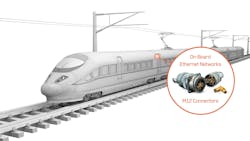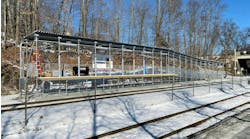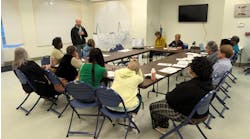The existing Train Communication Network (TCN) standard for data communication is no longer enough to keep up with the industry’s accelerating demand for higher bandwidth requirements.
Designed for real-time applications, the TCN standard is a hierarchical combination of two fieldbus systems: a wire train bus (WTB), which connects the equipment within a vehicle, and a multifunction vehicle bus (MVB), which connects the vehicles. This solution became the standard in part due to its low cost and extreme reliability, but also due to its simplicity. With WTB/MVB, there’s no risk of message collision. And when something does go wrong, there’s a very short recovery time.
Despite these advantages, the proliferation of new sensors, on-board processing and other electronic systems flooding the rail transportation industry in recent years has caused bandwidth requirements to skyrocket. New components and systems increasingly exceed what any fieldbus can provide.
In response, leading global train manufacturers have begun to supplement legacy systems with Ethernet technology in many on-board applications. At present, Ethernet is used predominantly for on-board video surveillance and information or entertainment systems, while most other systems function off separate TCN fieldbus interconnection networks.
What Comes Next: The “Full Ethernet Train”
In the near future, Ethernet will replace TCN entirely, carrying all data types needed for control, security and passenger information, from announcements to propulsion and lighting. The reason? Ethernet technology provides unlimited network length and reliability, with speeds surpassing one GBit/sec (compared to one MBit/sec with TCN WTB/MVB). Plus, this high level of performance is available in off-the-shelf products. It requires none of the higher customization, maintenance or replacement costs typical of rail-specific network equipment.
Still, upgrading your network isn’t as simple as buying a router. In order to ensure a smooth and cost-effective transition to high-speed Ethernet train networks, manufacturers will need to follow the steps below:
Step 1: Become Familiar with Implementation Challenges
Applying Ethernet technology in the on-board environment presents some technical challenges, both in terms of network configuration and component performance. The main challenge is compensating for fault tolerance. Due to train architecture and the length of time it takes for an information packet to travel along a network path, a network that’s resilient to the failure of one or more of its components is essential.
Equally important is ensuring that the data cabling and connectors deployed in the network satisfy railway fire and smoke standards as well as the mechanical and environmental requirements for vibration, sealing and temperature. This is especially true for vehicle-to-vehicle interconnects, which are subject to a wider range of stresses and climate changes.
Step 2: Define Network Performance Requirements
Once familiar with the challenges of implementation, the next step is to define the performance requirement for the Ethernet network in terms of either megabits or gigabits per second. This specification will depend upon the bandwidth requirements of the desired on-board systems.
Step 3: Select a Corresponding Ethernet Application
Next, determine a corresponding Ethernet application so that you can establish the network transmission hardware and protocol you will need. The appropriate Ethernet class for the application will be based on the network performance requirement as well as key variables such as train topology — particularly length — that will have a bearing on the required channel length for the network.
Step 4: Consider Cabling Options
The two main cabling standards in use today include twisted pair copper cable and fiber optic cable. Twisted pair copper cabling, used in many Ethernet networks, utilizes a pair of wires to form a circuit that can transmit data. Fiber optic cable is a somewhat more advanced option that transmits data as pulses of light through thin, flexible tubes of glass. It provides faster speeds and security, but is less versatile and much more expensive. Copper, on the other hand, is more physically robust and cost-effective. But it provides slower speeds and is at risk of interference when unshielded.
Step 5: Establish Connector Requirements
Once the performance requirements, Ethernet class, application and cabling standards have been defined, one of the most critical considerations is the interconnection of jumper cables between vehicles. The ideal solution is one that is reliable for use in harsh train environments and fulfills all requirements for both standard TCN and high-speed Ethernet communication, so the transition to full Ethernet trains is smooth and cost-effective. Selecting a circular M12 connector with advanced ruggedized RoHs compliant plating will ensure durability and performance. Additionally, some connector suppliers offer pre-tested cable assemblies to simplify integration
Putting It All Together
A major high-speed Italian rail network operator implemented this approach when designing their Ethernet network. Borrowing directly from state-of-the-art data center design, they created a sophisticated network architecture that was able to overcome the challenges of train topology and achieve a high level of fault tolerance.
Their approach? After defining network performance requirements, they used a highly specialized cabling scheme with fully shielded twisted pair cables and connectors to achieve performance well above Ethernet requirements. Then, when they realized they needed connector contacts with a higher network threshold than ITT Veam’s 4-pole M12 contacts that have been adopted by a few leading European train manufacturers, they contracted with ITT Veam to develop a custom solution. The resulting 8-pole M12 contacts not only met the target high performance level, but made it possible to mix WTB/MVB fieldbus and Ethernet services within a single connector, by combining multiple types of M12 contacts in the connector body.
The Promise of On-Board Ethernet Networks
The demand for higher connectivity is only going to increase from here. If you want to capitalize on the benefits of bandwidth-intensive data management systems and provide a next-level experience for operators and passengers alike, now is the time to get on board.
So thoroughly evaluate your needs, follow these steps and build your network with proven, future-proof components. This will enable you to transition to a fault-tolerant Ethernet network that adheres to the unique topology of the train and performs under even the most severe mechanical and environmental stress.



